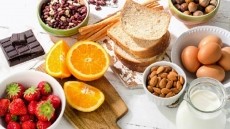Mood foods: Study shows eating more vegetables benefits mental health, opens door for innovative cognitive-boosting snacks

Scientists at the Grand Forks Human Nutrition Research Center conducted an eight-week study, which was part of a larger research project, to measure the correlation between vegetables and mental health of 75 men and women between the ages of 18 and 65. Researchers gave one group fresh pre-sliced vegetables while the control group, who experienced the same level of interaction from the researchers, were not given any. By measuring each group’s emotional wellbeing before and after eating, the study showed that the moods of the individuals who ate vegetables were significantly higher than the control.
Citing previously published research, scientists hypothesized how vegetables’ antioxidant and anti-inflammatory properties, along with Vitamin C, contribute to the brain’s production of feel-good neurotransmitters (serotonin, norepinephrine and dopamine).
The study underscores the importance of how portable, ready-to-eat vegetables are a chance for CPG manufacturers to capture consumer attention via innovative snack packs that enhance mood and nutrition.
Snack trends show consumers want to improve their diets through cleaner foods, giving snack makers an opportunity to produce innovative healthy indulgences
Given the FDA’s current proposal to update the definition of “healthy,” and consumer concern for nutritional findings, the results of USDA’s study arrive at an auspicious time for CPG manufacturers, particularly in snacking.
The snack category has seen significant growth through the four F’s of formulation: functional, fortified, free-from and fiber-filled. Similar to the USDA study’s findings, Mintel's 2023 Food and Drinks Trends report lists fruits and vegetables as “sources of increased energy and mood boosts." Including verbiage on packaging that explains how fruit and vegetables’ inherent nutritional content impacts gut-brain health will also drive this trend, giving snack makers incentive to reach consumers looking for whole, natural and nutritious ingredients.
Euromonitor’s “Five Key Snack Trends to Track in 2023” shows how consumers are looking to improve their diets through cleaner foods that are devoid of preservatives, less processed and more natural (i.e. dehydrated/baked vegetable chips and crackers, dips and sauces). Snacking for a treat, food replacement or out of boredom/distraction are listed in the report as reasons why consumers snack, underscoring how snack producers can optimize the category through innovation that pushes wellbeing.
Traditional unhealthy snacks are reformulated to contain plant-based and functional ingredients that address sleep, stress and general wellbeing, allowing for snack makers to deliver on ingredients and marketing that reinforces nutritious eating. Garden Lites Veggies Made Great lists zucchini and carrots as the first two ingredients of its Double Chocolate Muffins. Ark Foods’ savory snacks include vegetables like honey salted squash in its Honeynut Squash Snack Pack and Cauli Mac + Cheese, which is made of fresh cauliflower and vegan cashew cheese. Live Pure Smoothie Cubes lists its ingredients and benefits individually for each of its nine flavors. For example, Epic Mango contains mango for healthy digestion, coconut for energy and ginger as an anti-oxidant.
Additionally, food nutrition organizations are developing certification programs using icons to signal nutritious ingredients in foods and help raise nutrition standards and education nationwide. Partnership for a Healthier America’s (PHA) “Early & Often” campaign, for example, promotes veggie-forward foods with an icon that qualifying manufacturers can adopt on product packaging.
Rising food costs may prevent consumers from eating healthy while prescription meal programs offer a potentially cost-effective solution
With rising foods costs, despite a slower increase in 2023, 47% of consumers report that eating healthy is too costly, according to Euromonitor.
While the price of food may be a barrier for consumers, prescription food may be a cost-effective solution. As an ancillary segment in the health and wellness universe, prescription meals, groceries and programs are on the rise to reduce preventable chronic diseases and improve health eating habits across socioeconomic levels.
For CPG manufacturers, the opportunity lies in establishing value through reformulation and marketing that promotes nutrition and emotional and cognitive wellbeing.

















